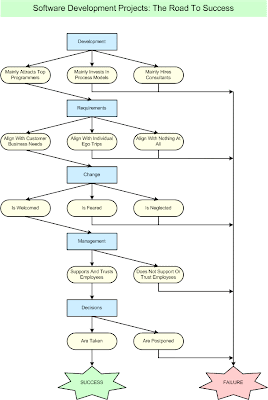First of all it's important to note that by default the Windows Taskmanager only shows the amount of physical memory acquired. There is another column for displaying virtual memory usage, but it's not visible originally. So when physical memory usage drops, it's not always necessarily the CLR returning memory, but probably physical memory being swapped out to disk.
So memory consumption drops at some point in time - just probably too late. Those symptoms give us a first clue that we are not dealing with memory leaks here (of course memory leaks are more unlikely to happen in managed environments than in unmanaged ones, still it's possible - e.g. static variables holding whole trees of objects that could otherwise be reclaimed, or that EventListener that should have been unregistered but wasn't). Also, whatever amount of native heap the CLR has allocated, the size of the managed heap within that native heap is a whole different story. The CLR might just have decided to keep native memory allocated even if it could be free'd after a garbage collection pass.
And this does not look like a big deal at first glance - so what if the CLR keeps some more memory than necessary, as long as it's being returned once in a while? But the thing is, the CLR's decisions on when the right moment for freeing memory has arrived (or for that matter, the OS swapping unused memory pages to disk) might not always coincide with the users' expectations. And I have also seen Citrix installations with plenty of .NET Winforms applications running in parallel, soaking up a lot more resources than necessary, hence restraining the whole system.
Some customers tend to get nervous when they watch a simple client process holding 500MB or more of memory. "Your application is leaking memory" is the first thing they will scream. And nervous programmers will profile their code, unable to find a leak, and then start invoking GC.Collect() manually - which not only doesn't help, but is a bad idea generally speaking.
Under Java there is a way to limit the default maximum heap size (the default value depends on the Java VM), which can be overridden by passing the "-Xmx" commandline parameter to the runtime. Once the limit is reached, the garbage collector will be forced to run once more, and if that doesn't help any more either, an OutOfMemoryError is thrown. This might be bad news for the Java application, but at least it will not bring down the whole system.
I don't know of a counterpart to "-Xmx" in the .NET world. Process.MaxWorkingSet property allows for limiting the physical memory a process may occupy. I have read several postings recommending this approach to keep the whole .NET memory footprint low, but I am not so sure, plus setting Process.MaxWorkingSet requires admin privileges - something that application users will not (and should not) have.
A better choice is the Win32 API function SetProcessWorkingSetSize() with two special paramater values: -1.
From MSDN:
BOOL WINAPI SetProcessWorkingSetSize(
__in HANDLE hProcess,
__in SIZE_T dwMinimumWorkingSetSize,
__in SIZE_T dwMaximumWorkingSetSize
);
If both dwMinimumWorkingSetSize and dwMaximumWorkingSetSize have the value (SIZE_T)-1, the function temporarily trims the working set of the specified process to zero. This essentially swaps the process out of physical RAM memory.
What SetProcessWorkingSetSize() does is to invalidate the process's memory pages. what we have achieved at this point, is that our application's physical memory usage is limited to the bare minimum. And all that unused memory - as long as it is not being accessed, it will not be reloaded into physical memory. The same is true for .NET Assemblies which have been loaded, but are not currently used.
And the good news: this does not require the user to have admin rights. By the way, SetProcessWorkingSetSize is what's being invoked when an application window is minimized, which explains the effect described above.
I should not that there might be a performance penalty associated with that approach, as it might lead to a higher number of page faults following following the invocation, in case other processes regain physical memory in the meantime.
Obviously Windows' virtual memory implementation can not always swap out unused memory as aggressively. And it's my guess that what might hinder it furthermore is the constant relocation of objects within the native heap caused by garbage collection (which means a lot of different memory pages are being accessed over time, hence hardly ever paged to disk).
A Timer can be applied for repeated invocations of SetProcessWorkingSetSize(), with a reasonable interval between two calls of maybe 15 or 30 minutes (this depends heavily on the kind of application and its workload). Another possibility is to check from time to time on the physical memory being used, and once a certain amount has been reached the call to SetProcessWorkingSetSize() will occurr. A word of warning though - I do not advocate to invoke it too often either. Also, don't set the minimum and maximum working sizes (let the CLR take care of that), just use the -1 parameter values in order to swap out memory, after all that's what we are trying to achieve.
The complete code:
[DllImport("kernel32")]
static extern bool SetProcessWorkingSetSize(IntPtr handle, int minSize, int maxSize);
SetProcessWorkingSetSize(Process.GetCurrentProcess().Handle, -1, -1);
Anyway, our Citrix customers are happy again, and no one has ever screamed "Memory leak!" since we implemented that workaround.


